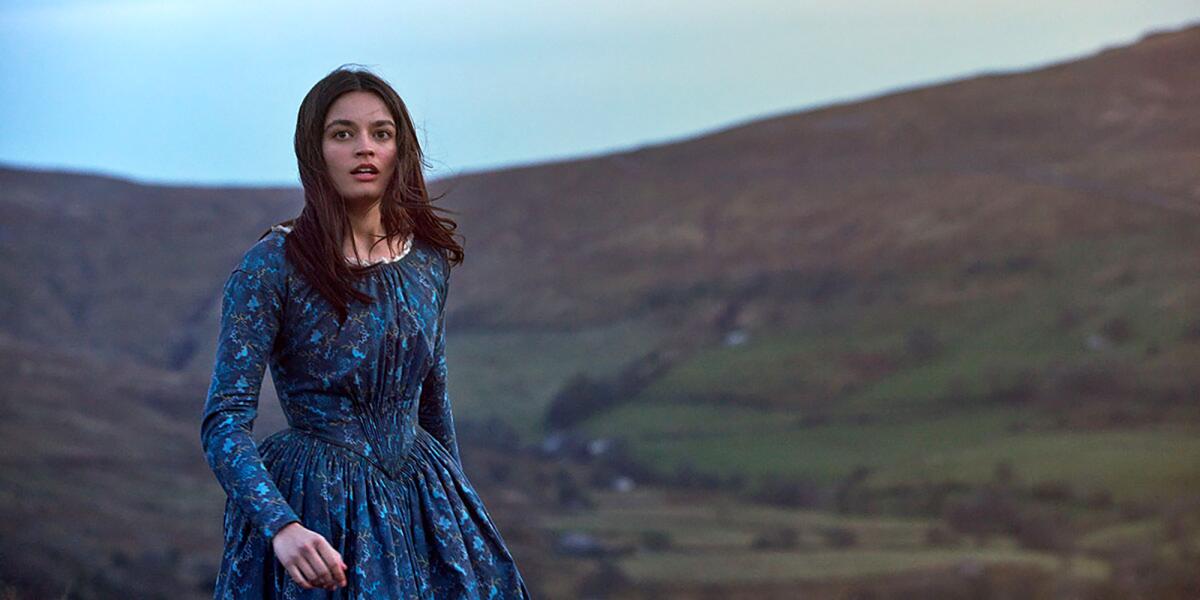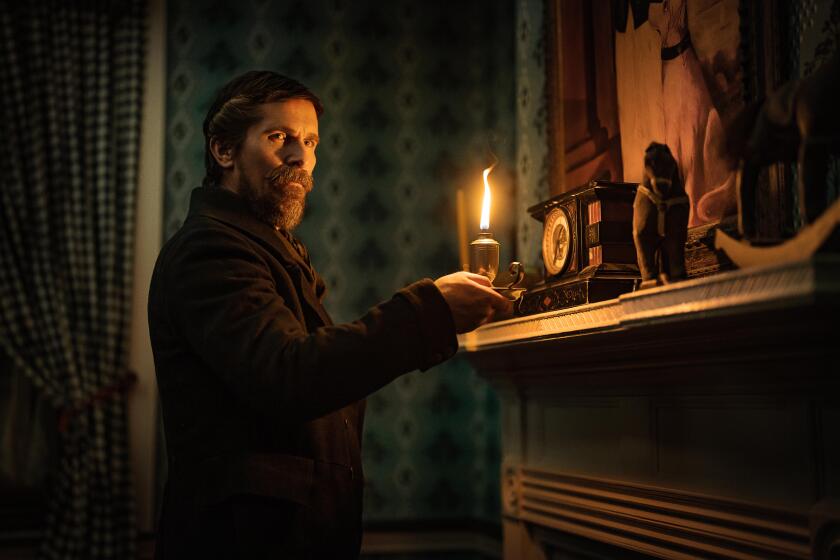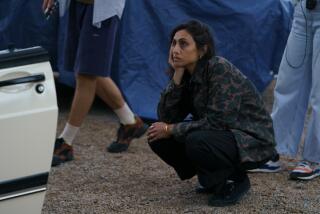A new film’s liberties with Emily Brontë may ‘court controversy.’ Is that so bad?

- Share via
LONDON — Despite the vast amount of scholarship that’s been produced about the Brontë sisters, Emily Brontë, the author of “Wuthering Heights,” remains something of a mystery. Because of her reclusive nature, relatively little is known about the poet and author, who died at age 30. But it’s this enigmatic quality that makes her the perfect inspiration for a film — most recently, writer-director Frances O’Connor’s “Emily.”
O’Connor’s interest in bringing Brontë to the screen dates back to the late 1990s, when she was shooting “Mansfield Park.” During a break in production, O’Connor toured the Brontë Parsonage Museum in Haworth, England, and felt something “activate” in herself. Years later, as the actor began to consider what sorts of stories she might want to tell, O’Connor returned to Brontë. Instead of making a literal biopic, though, O’Connor thought there would be more truth in a dramatized version of the writer’s life.
“I wrote this the way Emily wrote ‘Wuthering Heights,’” O’Connor explains of the film, which is impressionistic and moody. “She did the research, she let her imagination go to these deep, dark places and then this work came out. I let my research be in different avenues and then I used those elements to craft a story that is about who she is — somebody who had a very authentic voice but didn’t really fit in. A lot of women feel like that or have felt like that.”
The film, opening in Los Angeles on Friday, stars Emma Mackey as Emily, and draws on both historical fact and creative imagining. While writing the script, O’Connor read every book she could find. Her most essential sources were “The Brontë Myth” by Lucasta Miller and “The Brontës” by Juliet Barker; the Brontë Parsonage Museum also offered research and insight.
Distorted pictures of their lives have not served the sisters well
Although some scholars have voiced frustration that “Emily” isn’t completely accurate, the fictionalized aspects were primarily used to fill in existing blanks.
“There were very few records of [Emily’s] life,” explains Ann Dinsdale, principal curator of the Brontë Parsonage Museum, adding that the author didn’t really form friendships outside the family. “So while we’ve got a wealth of material connected with Charlotte — we’ve got literally hundreds of letters that she wrote to friends and then other writers when she became a celebrity author — we just don’t have that material in the case of Emily. So a lot of it is down to your own interpretation of the scanty evidence that survives. It’s always really interesting to see other people’s ideas about Emily.”
One of the great debates about Emily Brontë is whether she ever had a romantic relationship. Some scholars believe that the author couldn’t have written “Wuthering Heights” without experiencing real-life love. Others, such as Dinsdale, take the opposite view: It’s because she never had a relationship that the book is so singular.

In the film, O’Connor gives Emily a passionate affair with William Weightman (Oliver Jackson-Cohen), a young curate in the local parish. Although historians concur that Anne Brontë — and possibly Charlotte — fancied Weightman, there is no evidence that Emily did. In the context of “Emily,” however, Weightman is key to understanding her.
“For me, in the film the church represents the patriarchy and Emily’s wild nature represents the female, the creative, the dark and the moon,” O’Connor explains. “So you’ve got these two opposing forces in the film. If you take a character like Weightman, he is connected to the patriarchy. He eventually has to go back into that position of structure and masculinity and say [to Emily], ‘There is something ungodly about you.’ I was interested in having that discussion.”
Mackey was initially nervous about the imaginative nature of the film, particularly the pressure of embodying such a beloved literary figure. Eventually, though, after doing her own research, the actor focused solely on the script and O’Connor’s vision.
“In the same way that ‘Wuthering Heights’ needs to be experienced as a book without you placing your analytical mind on it, I think this film can’t really be pinned down,” Mackey says. “It’s a period drama; it’s also not at all a period drama. It’s not stuck in a time. It feels like it can talk to different kinds of generations of people. I just wanted people to feel surprised by it in the same way that I was when I read it.”
One of the most fascinating discoveries for O’Connor was the existence of a porcelain mask that was given to Patrick and Maria Brontë as a wedding gift. It was handed to the Brontë siblings to hide behind when they were children and needed courage to speak. The whereabouts of the mask are unknown, but it reappears in the film as Emily wears it to channel her late mother.
“It became a great object of Emily’s creativity, but the dark aspect of it,” O’Connor notes. “It’s almost like a talisman.”
At the core of the film is a sense of who Emily Brontë might have been. O’Connor uses both the historical details and the fictional aspects to offer the viewer an impression of Emily as rebellious, untethered and resolutely self-assured — traits she feels are relatable to young viewers.
‘A film shouldn’t be like an enema,’ says writer-director Scott Cooper. Here’s how he and frequent collaborator Christian Bale stretched its suspense.
“I really do feel that Emily has something to say to this current generation,” O’Connor explains. “Here is a story in which young women are in the middle of exploring who they are. For a lot of women, actually, being your authentic self comes at a cost because the patriarchy doesn’t really reward it very much.”
“Her life was probably a lot more boring than the film, but she knew what she wanted,” Mackey adds. “She was quite strong-minded. I think you can kind of get a sense of that in her writing. She just was so free. She doesn’t impose any rules on herself at all. And so that was quite liberating to do in the film.”
O’Connor’s script, along with costumes and props from the film, are on display in the Brontë Parsonage Museum. Since the movie’s U.K. release last year, Dinsdale has, in fact, noticed an uptick in interest from visitors in their teens and 20s. For the museum, it’s not about fact versus fiction, but instead about renewed excitement for the subject matter.
“Wherever the Brontës are concerned, passions run high,” Dinsdale says. “People get very attached to the Brontës [and] to the idea of them, and you’re always going to court controversy in any adaptation about their lives. But my view is that anything that generates new interest in ‘Wuthering Heights’ and in English poetry has got to be a good thing. And clearly, the film has done that.”
More to Read
Only good movies
Get the Indie Focus newsletter, Mark Olsen's weekly guide to the world of cinema.
You may occasionally receive promotional content from the Los Angeles Times.











